The aerospace industry has been gathering at Farnborough to show off its wares over the last 70 years.
During those seven decades, there have been some remarkable pieces of hardware and technology exhibited while the industry’s top pilots have wowed the crowds manoeuvring their machinery through some impressive flying displays.
Organised by what was originally dubbed the “Society of British Aircraft Constructors”, the SBAC air show made its debut at Farnborough in 1948. This was in fact the ninth SBAC show, with the event having begun at Hendon in North London in 1932 as the “New Types Park” within the annual Royal Air Force Pageant.
In 1936 the annual event moved to the nearby de Havilland airfield, Hatfield, but there was to be only one more show before the onset of war. The first post-war show was held in 1946 at the Handley Page works at Radlett – again a north London location. It remained there for one year be-fore taking up a residence which continues to this day at what was then the Royal Aircraft Estab-lishment field at Farnborough.
Since that debut event in 1948 there have been many memorable moments across the decades.
We’ve delved into the FlightGlobal archives to flashback to some of the interesting aircraft and events from the past 70 years.
Get all the coverage from the Farnborough air show 2018 on our dedicated event page
1948 First Farnborough
The industry gathered during the sunny – if slightly windy – first week of September 1948 for the inaugural show at the Hampshire airfield. Flight wrote in our show report: “That the Ministry of Supply airfield at Farnborough, Hants, should have been made available for the 1948 Display and Exhibition of the Society of British Aircraft Constructors is a matter for congratulation of the Society and for thanks to the Ministry.”
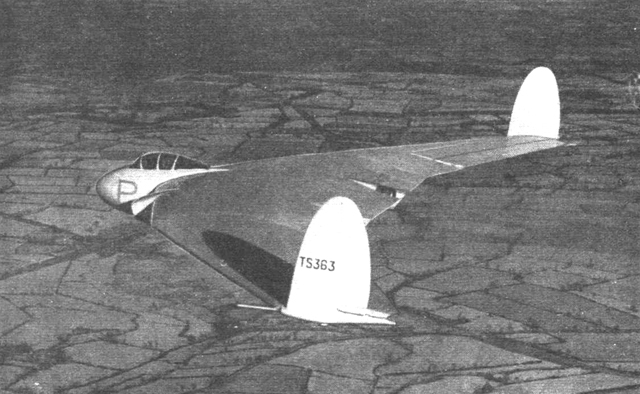
FlightGlobal Archive
We were clearly supportive of the decision to relocate to Farnborough: “Adoption of the new ven-ue – which imposes fewer traffic restrictions than Radlett and, more important, allows the long-proposed admittance of the public – should swell the Exchequer by promoting export sales, bene-fit British prestige and stimulate public morale.”
Among the notable aircraft on display was the Armstrong Whitworth AW52 flying wing. Almost as large as an Avro Lancaster bomber, it was envisaged that this jet-powered design would eventually be developed into an airliner.
1949 Comet cometh
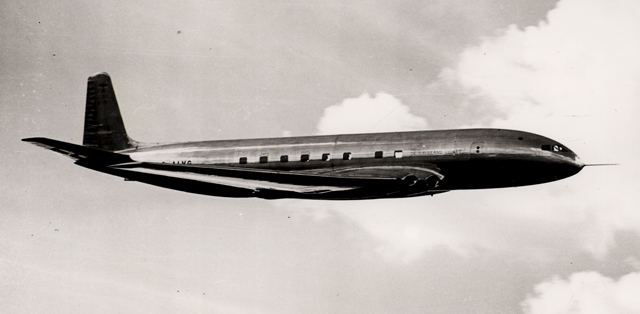
FlightGlobal archive
The industry had its first glimpse of future air travel when the de Havilland Comet jet airliner de-buted at Farnborough in 1949. Flight could hardly contain its excitement when describing the sleek airliner’s display: “A fast, hushed run across the airfield was followed by a wide, low-level turn at slow speed, which revealed in full a degree of grace never before achieved in the design of so large an aircraft. Although it flew for the first time only on July 27th, development flying has pro-gressed rapidly and a Mach number of 0.8 has already been reached at altitude.”
1950 Bristol’s behemoth
Farnborough began its long-running tradition in 1950 of being “the land of the giants” when the huge Bristol Brabazon airliner made its debut.
Displayed alongside the Comet, Flight described the two machines as sharing the distinction of be-ing the most widely discussed airliners to be produced by any nation since the war.
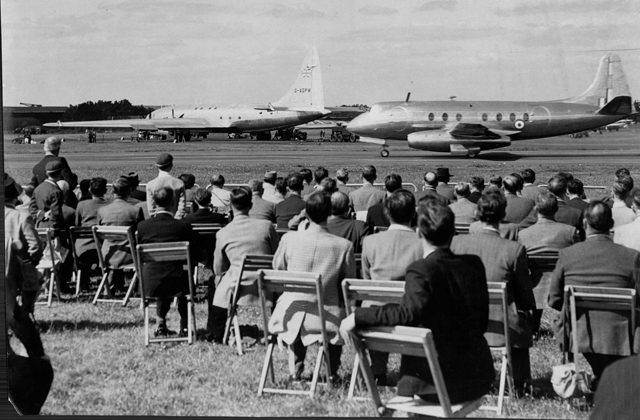
Ernest Allen/Associated Newspapers/REX/Shutterstock
“There are solid technical reasons for such fame and both aircraft give an immediate impression of beauty and efficiency,” said Flight. “The stately Brabazon prototype, powered by coupled Centau-rus piston engines, is the forerunner of a later version with Proteus turboprops, specifically de-signed for long-range operation – in particular, nonstop between London and New York.”
The show also featured more new engine technology demonstrations, with Vickers showing off its modified Viscount equipped with Rolls-Royce Tay turbojets installed in a configuration that would later be mimicked by the Boeing 737-100/200.
1952 Avro arrival
The 1952 event witnessed a remarkable debut display by Avro’s new delta bomber just days after its first flight. But the tragic crash of the de Havilland DH110 into the spectator area was the abiding memory of this show.
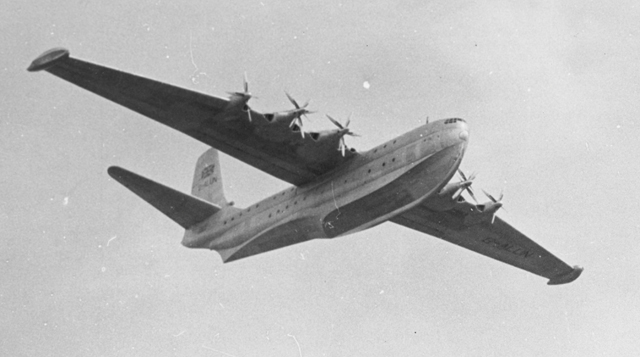
FlightGlobal Archive
Flight described the first public appearance of what would become the Vulcan as “an occasion which promises to become historic”, declaring the futuristic aircraft had “stolen the show and opened the eyes of the world”.
Saunders Roe’s giant Princess flying boat also graced the skies, flying over from the waters of So-lent each day. Although it appeared to be nostalgic blast from the past, this 100-seat double-decker powered by 10 Bristol Proteus turboprops, had only completed its maiden flight the previ-ous month. Sadly, its impressive display in the Farnborough skies did nothing for its sales prospects as the world had moved on from sea- to land-planes.
1958 Roto dynamics
The Fairey Rotodyne “heli-liner” was the star attraction at the 1958 Farnborough which made its public debut. With its “tip-jet” powered rotors, FIight described the unusual aircraft as sounding like “a paddle-steamer as it starts up” but said it “proves itself a liner in every sense”.
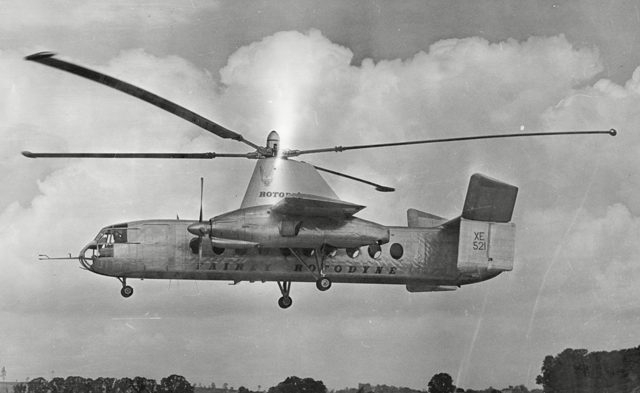
Associated Newspapers/REX/Shutterstock
The display involved the Rotodyne rising vertically as a helicopter and hovering briefly before re-tracting its undercarriage and setting off. “Translation from helicopter to autogiro flight is made at about 1,000ft and at a speed of 115mph,” said Flight. “It passes the enclosure at perhaps 170mph – in any case at a speed in excess of the world helicopter record of 162mph.”
1962 Jumping Jet
Vertical take-off was the big talking point at Farnborough 1962, as Hawker’s P1127 made its debut. This single-seater, which was the precursor to the Harrier, began what would become a long-standing tradition of the British V/STOL jet wowing air-show crowds.

Associated Newspapers/REX/Shutterstock
This show, which was also the last time it was held annually, was an important one for the UK’s civil aircraft programmes with the de Havilland Trident, Vickers VC10 and DH125 business jet all making their maiden appearances.
W/C Ken Wallis also debuted his single-seat autogyro which would go on to find fame as 007’s cho-sen form of air transport – dubbed “Little Nellie”– in You only live twice.
1966 Red dawn
From 1966, foreign aircraft were allowed to participate at the Farnborough air show with the one proviso – that they had British powerplants or major components.

FlightGlobal Archive
This move permitted aircraft like the Rolls-Royce-powered Aermacchi MB326 trainer and Fokker F27 turboprop to make their first appearances.
But making their debut – and a Farnborough favourite ever since – were the nine brightly-coloured Hawker Siddeley Gnat T1s of the Royal Air Force aerobatic display team, The Red Arrows, led by the legendary Sqn Ldr Ray Hanna.
1970 Sonic tonic
As the industry moved into the 1970s, speed and size were dominating the airliner sector. Con-corde had begun flight-testing in April the previous year, so the elegant machine was well into its trials programme by the time it made its debut at Farnborough.
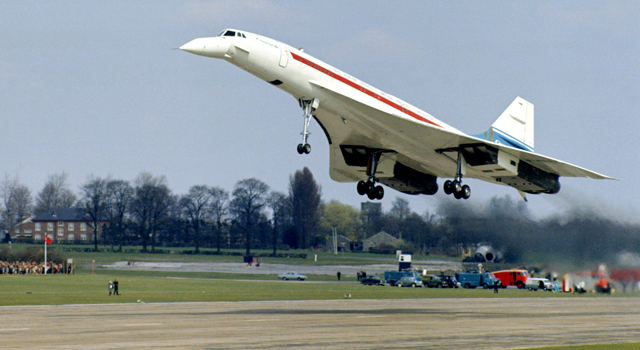
FlightGlobal Archive
The British-built Concorde prototype 002 made a triumphant arrival each day over the Farnborough skies, being flown in by Brian Trubshaw and John Cochrane from its Fairford flight-test base. The slender delta would go on to wow Farnborough crowds for many years to come.
1972 Flying triangles
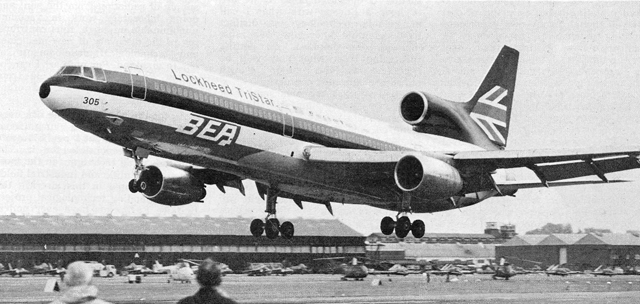
FlightGlobal archive
The debut of the Saab Viggen in 1972 gave the crowd something to get excited about. Flight de-scribed the “double-delta” fighter as giving “a searing demonstration” as it rolled around the Farn-borough sky. Lockheed was keen to show off its new widebody, the TriStar as the Rolls-Royce RB211-powered trijet had already been chosen by two UK airlines including national carrier BEA in whose colours it was exhibited.
1974 Black beauty
Lockheed’s rocket ship, the SR-71 Blackbird, was the talk of Farnborough 1974. Flight recorded the Mach 3 aircraft’s arrival thus: “The opening curtain is stolen by the Americans, whose SR-71 lands from New York as the President’s international guests gather for the flying display. A note passed to Sir Harry Broadhurst and SBAC director Sir Richard Smeeton simply says: ‘1 hr 55 min 45 sec’. Fif-teen hundred pressmen have their show-opening story.”
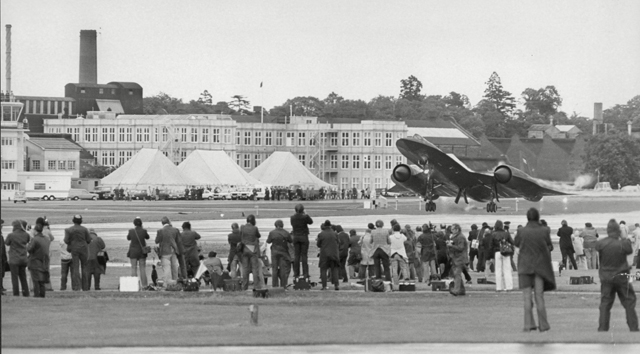
Associated Newspapers/REX/Shutterstock
If speed wasn’t your thing, the Lockheed line-up still had something to offer in the form of the show’s largest-ever exhibit – the giant C-5 Galaxy military airlifter.
1982 Twinjet tussle
Transatlantic rivalry in the civil aviation field ratcheted up at Farnborough ’82 when Airbus and Boe-ing’s new widebody twins went head-to-head. The A310 was flying the flag for Europe while Boe-ing brought the 767 – along with its narrowbody sibling the 757 – as the rivals battled for sales su-premacy in a key market.

FlightGlobal archive
The excitement on the military side was created by Rockwell’s big swing-wing bomber, the B-1A. The programme had been salvaged by the recently inducted President Reagan and Rockwell brought the fourth prototype out of storage for its Farnborough sojourn.
1986 Fighter foes
The star attractions at the 1986 show were the British Aerospace Experimental Aircraft Programme (EAP) and Dassault Rafale fighters. In our show preview, Flight pointed out that in the fighter-export market the UK and France were the closest and fiercest rivals. “That rivalry is epitomised at Farnborough by the presence of the EAP and Rafale technology demonstrators,” said Flight. “These new aircraft which flew within a month of each other this summer, are not only the begin-nings of Europe’s future fighters but also embody France and Britain’s future export hopes.”
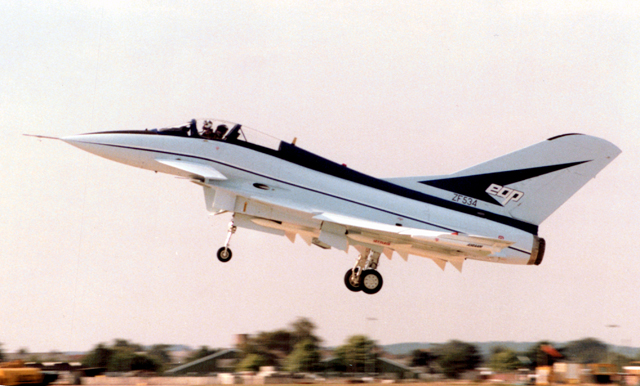
FlightGlobal archive
The EAP would feed into the development of the Eurofighter, but Farnborough attendees would have to wait another decade before seeing the Europe’s jointly developed interceptor perform in the flying display.
Meanwhile as Airbus prepared to redefine commercial airliner thinking with its sidestick-equipped, fly-by-wire A320 (which debuted in 1988), it showed off the technology’s capabilities with an im-pressive display by its A300 development aircraft. “The crew concentrated on showing the wind-shear stall protection which computerised control gives at the bottom end of the flight envelope by flying at devastatingly high angles of attack with apparent ease and safety,” wrote Flight.
1988 Bypass operation
McDonnell Douglas brought its MD-80 ultra-high-bypass (UHB) demonstrator to Farnborough for the first public demonstration of the propfan-powered aircraft. Flight reported that McDonnell Douglas aimed to use the GE-powered demonstrator “in the evenings to take up potential cus-tomers for its UHB-powered MD-90 series”. But that plan was not a success and three decades on, propfan-powered airliners resolutely remain an aspiration rather than a reality.

FlightGlobal archive
The Soviets turned up in force in 1988, with the giant Antonov An-124 Ruslan airlifter making its de-but alongside two MiG-29 fighters, which Flight described as “perhaps the biggest crowd-pullers at this year’s Farnborough” in our show report, adding: “The Soviet Union’s decision to exhibit the aircraft was given maximum backing, and a high ranking delegation from the Mikoyan design bu-reau (OKB) was on hand to answer questions about the aircraft.”
1996 Eurofighter debut

Associated Newspapers/REX/Shutterstock
This was the year that the Eurofighter finally made its long-awaited debut at Farnborough, with a thundering flying display to show off the new interceptor’s impressive performance. A decade af-ter Farnborough crowds had a glimpse of the technology with the BAe EAP and after years of mak-ing do with plastic mock-ups, the British prototype DA2 was finally able to show off its airborne ca-pabilities.
2006 Big wing
The biggest aircraft to ever appear at Farnborough made a triumphant flypast on its debut in 2006 as Airbus test pilot Peter Chandler in the A380 led the Red Arrows down the crowd line as UK prime minister Tony Blair looked on. The A380, which was in the midst of its flight-test programme, head-ed off at the conclusion of the show to carry out high-energy rejected take-off trials.

Airbus
2012 Boeing’s back
After an absence for a generation – in fact 13 Farnborough air shows – a Boeing airliner was back in the flying display in 2012. The first 787 Dreamliner for Qatar Airways was put through its paces each day with an impressive demonstration. Boeing’s long-held view had been that airliners aren’t de-signed to be shown off at air shows and flying them in displays didn’t sell aircraft. But when Qatar Airways chief executive Akbar Al Baker stated his desire for his new jet to be shown off at Farn-borough, who was Boeing to deny him?
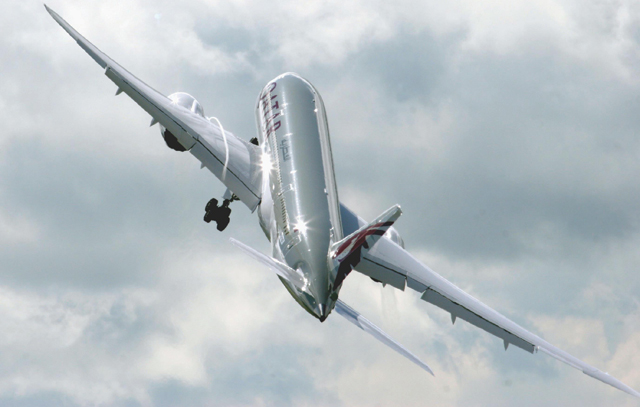
Max Kingsley-Jones/FlightGlobal
2016 Late strike
Two years later than planned, the Lockheed Martin Joint Strike Fighter made its show debut in 2016. The JSF had originally been expected in 2014, but a technical issue forced a US Department of Defense grounding in the run-up to the show. The UK’s first F-35B was displayed at Farnborough 2016, joined by two US Marine Corps examples.
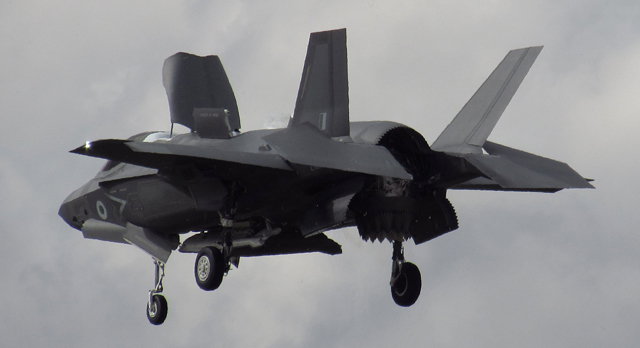
Max Kingsley-Jones/FlightGlobal
2018 Tempest Two
The unveiling of a full-scale model of the “Tempest” concept on the opening day provided a vision for the UK's next-generation fighter. The aircraft which, like the Eurofighter Typhoon, adopts an RAF heritage fighter name, bolsters the UK Ministry of Defence's new Future Combat Air strategy.
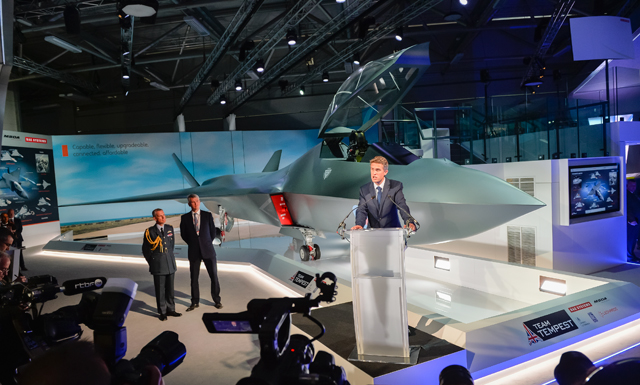
BillyPix
The 2018 show also featured the flying-display debut of Mitsubishi’s new MRJ regional jet, although plans for the aircraft to appear everyday were hampered after a ground-handling incident on day two.
Price of progress: tragedy strikes
Tragedy struck Farnborough in 1952 when de Havilland’s handsome new supersonic fighter, the DH110, disintegrated and crashed into the spectator area.
The accident happened during the display after the DH110’s supersonic arrival from de Havilland’s Hatfield plant. The two crew were killed, including distinguished test pilot John Derry DFC and his observer Tony Richards, as well as 29 members of the public. A further 60 were injured – many on-ly slightly – by parts of the aircraft.
Our report on the accident explained how the break-up appeared to begin just before a steep 90˚ turn towards the enclosures: “Small fragments came away from the 110, which gained height as the two Avons and the nose became detached from the airframe. One engine fell on a crowded slope behind the caravan parks, causing most of the casualties; the other landed harmlessly farther south.”
Flight summed up the industry’s mood immediately after the tragedy in its leading article: “Seldom has the truth of the reflection that ‘such is the price of progress’ been demonstrated with such appalling effect.”
A faulty leading-edge design was blamed for the accident. The redesigned DH 110 returned to the air in June 1953 and was eventually developed into the successful Sea Vixen naval fighter. The acci-dent resulted more stringent safety measures at air shows preventing aircraft from operating too close to the crowd line.
In 1984 the crowd got to witness another dramatic event in the flying display, but this time thank-fully without a tragic outcome. A steep descent by the de Havilland Canada Buffalo to demonstrate its short-landing capability ended in a fiery crash as the transport hit the runway hard and disinte-grated. The only harm suffered was to the crew’s pride, as the investigation pointed to “an error of judgement by the aircraft commander”.
Source: FlightGlobal.com






















